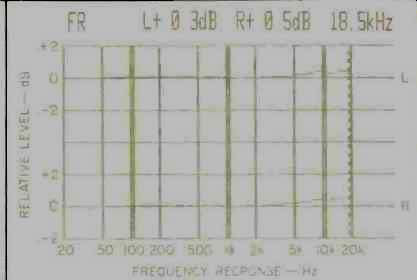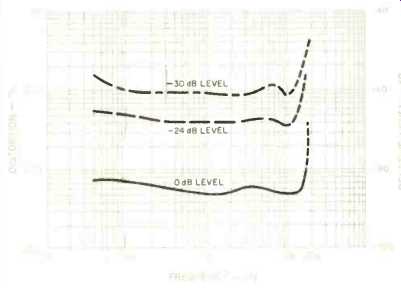
Manufacturer's Specifications
Frequency Response: 2 Hz to 20 kHz, ±0.5 dB.
Dynamic Range: Greater than 95 dB.
Total Harmonic Distortion: Less than 0.0015% at 1 kHz.
Channel Separation: 90 dB. Output Level: 2.0 V.
Number of Programmable Selections: 16.
Wow and Flutter: Below measurable limits.
CHIPSET: Sony CX20017 (non-oversampling?); SM and schematics same as Toshiba XR-z70, Uher x-2, Luxman DX-103, Alpine AD-7200, NAD 5200.
Dimensions: 17.3 in. (44 cm) W x 3.46 in. (8.8 cm) H x 12.2 in. (31 cm) D.
Weight: 15 lbs. (6.8 kg).
Price: $899.00.
Company Address: 1315 East Watsoncenter Rd., Carson, Cal. 90745.
Some companies rushed right in to the CD foray, offering first-, second- and even third-generation CD players within the first year of Compact Discs' availability. Others chose to wait a while, preferring to see what features and configurations met with the greatest success and acceptance by those audio enthusiasts ready to plunge in to digital audio. Kenwood falls into the latter group. Their first full-featured CD player, the Model DP-1100B, turns out to be a good example of careful design and layout, with operating controls that are simple to use and logically placed.
As for operating features, the DP-1100B can be programmed to play as many as 16 tracks, in any order. Furthermore, you may specify a desired selection by index number within a track number. This is handy, as more record companies begin to subdivide longer selections into smaller, indexed segments. The numeric keypad found on the player's front panel (and on the supplied remote control) permits you to quickly access any track on a CD, even up to track 99, in the unlikely event that a disc contains so many tracks. (One of my test discs actually does have more than 90 separate tracks on it, but it's hardly typical.) This CD player can be made to play the next track or the previous one at the touch of a button. It can find a desired track within a couple of seconds and then either play it, or pause until you instruct it to proceed. It can be instructed to repeat-play an entire disc or any portion of the play program stored in memory. If you change your mind about the tracks stored in memory, touching a single button returns you to manual (non-memory) play. In short, whether at the front panel or with the supplied wireless remote control in hand, you have total control over the music you want to hear and the order in which you'll hear it.
Control Layout
The on/off switch is located at the upper right corner of the front panel. Below this switch is a stereo headphone jack, and immediately to its right is a slide-type headphone output-level control. The now-familiar disc-loading drawer, with an "Open/Close" switch on its front surface, is near the top of the panel; just below are 10 tiny numeric keys which are used either to select tracks to be played or, with the aid of a nearby "Memory" switch, to program tracks and index numbers for playback in random order. A "Memory Read" switch, when depressed one or more times, sequentially displays the track and index numbers stored in memory. A "Clear" button to the right of the "Memory Read" button is used to clear the currently displayed track number. This same switch, when depressed along with the "Memory" button, will clear the entire stored program.
When the DP-1100B is first turned on, the time indicator in the display area shows the ongoing playback time of each track as it is being played. Pressing the "Time" button makes the display show the elapsed playing time of the disc, while pressing this button a second time shows remaining time on the disc.
Controls located below the display area include the "Repeat," fast-forward and fast-back buttons and a pair of forward and reverse "Music Search" buttons. When either the fast-forward or fast-back switches is depressed during playback, the player performs cue or review functions, with music audible at lower levels as the laser pickup rapidly scans the disc. The "Music Search" switches are used to advance track numbers or to return to the beginning of the current selection or even to skip tracks in reverse. The "Stop," "Pause" and "Play" buttons are at the right end of the front panel, and an indicator light near the "Play" button illuminates when a disc is actually being played.
The display area gives the user a lot more information than just track and index numbers and time notations. A "Disc" light illuminates if a disc has been loaded into the drawer, and an "M-Play" light is on during memory playback. Numbers along the lower edge of the display light up to indicate which track numbers have been stored in memory. An "M-Scan" light comes on when the scan key on the remote control is activated. "Memory Indicator" blinks to show how many tracks can still be programmed into memory; during memory play, it shows which programmed selection is being played back. Finally, a "Repeat" indicator lights when the "Repeat" switch has been depressed and the unit has entered the repeat mode.
As comprehensive as the display is, and as elaborate as the available functions of this player are, the front panel is surprisingly uncluttered, thanks to the multiple-function switches and buttons and to the intelligent layout devised by the DP-1100B's designers. The rear panel is equipped with nothing other than a pair of output jacks and, of course, the a.c. power cord.
Measurements
Figure 1 shows a plot of frequency response for both the left and right channels of the DP-1100B. The vertical scale is 2 dB per division, and the sweep, from left to right, extends from 20 Hz to 20 kHz. Frequency response was quite flat, exhibiting a very slight rise at the extreme high end (between +0.3 and +0.5 dB at 18.5 kHz).

Fig. 1--Frequency response, left (top) and right channels, at 0-dB level.

Fig. 2--THD vs. frequency at three signal levels.

Fig. 3--Spectrum analysis of 20-kHz test signal shows the usual, inaudible
24.1-kHz beat tone, here 53 dB below the desired tone.

Fig. 4--S/N analysis, both unweighted (A) and A-weighted (B).

Fig. 5--Separation vs. frequency.
Harmonic distortion for maximum output varied from 0.005% to around 0.008%, depending upon the test frequency being measured. A plot of THD versus frequency up to around 10 kHz, measured at various recorded levels, is shown in Fig. 2. Above 10 kHz, I encountered the now familiar rise in apparent THD. As can be seen in Fig. 3, however, this rise is not actually an increase in THD but, rather, is caused by a "beat" frequency occurring outside the range of hearing, above 20 kHz. In Fig. 3 a test tone of 20 kHz was used (the tall spike in the 'scope photo), and to the right of this primary tone can be seen the beat tone at approximately 24.1 kHz (interaction between the 44.1-kHz sampling rate and the 20-kHz tone being reproduced). This secondary tone was more than 50 dB below the desired 20 kHz tone and would therefore not be likely to cause problems with wide-band amplifiers and wide-range tweeters.
Unweighted signal-to-noise ratio measured 94.1 dB and is illustrated in Fig. 4A; with an A-weighting filter included in the measurement, signal-to-noise ratio increased to 98.2 dB, as shown in Fig. 4B. At maximum recorded levels, IM distortion measured 0.0025%, increasing to 0.02% at -20 dB recorded levels. Linearity was accurate to within 0.4 dB down to -80 dB. Stereo separation (Fig. 5) ranged from 83 dB at the low and high frequency extremes to around 88 dB at mid-frequencies.

Fig. 6--Square-wave reproduction, 1 kHz.

Fig. 7--Single-pulse test.

Fig. 8--Twin-tore phase test (200 Hz and 2 kHz).
Reproduction of a 1-kHz, digitally generated square-wave signal (Fig. 6) was typical of that encountered with CD players which use multi-pole, steep analog filters following digital-to-analog conversion. (aka: non-oversmapling). The same was true of the reproduction of a digitally generated unit-pulse signal, as shown in Fig. 7. Negligible phase shift between a left channel, 200-Hz test signal and a right-channel, 2-kHz test signal was observed in the 'scope photo of Fig. 8, though greater phase shift would have been evident at higher test frequencies. Perfect phase linearity in this test is represented by a positive crossing of the zero axis at the same time for both test frequencies.
Although the Kenwood CD player had no difficulty playing through the entire simulated fingerprint on my special Philips test disc, I was surprised to find that my sample did mistrack when attempting to play through the opaque wedge incorporated on the surface of this same disc, beginning to mistrack when the wedge reached a width of only 500 microns. The same sort of mistracking occurred when I attempted to play through the simulated dust spots on the test disc. Again, mistracking occurred when the laser beam encountered a dot having a diameter of only 500 microns.
There was no easy way for me to determine whether this mistracking was caused by misadjustment of the servo-tracking system in the particular sample I tested, or whether it was due to inferior error-correction circuitry in the player.
Use and Listening Tests
The fact is that, during subsequent listening tests, using a wide assortment of CDs which have been played countless times (I do have my favorites!), no mistracking of any kind occurred. I'm not altogether certain that checking every single CD player with the specially designed Philips defects disc is entirely definitive, but for the moment I have no alternative. Reviewers such as myself desperately need test discs that will tell us more than the few such CDs available now.
Only weeks ago, a committee was formed under the aegis of the EIA (Electronic Industries Association) to develop uniform testing standards for CD players. Such a standard would be similar in format to earlier standards now in wide use for evaluating tuners, amplifiers, phono cartridges, turntables, and tape decks.
Operating the Kenwood DP-1100B was fairly easy after quickly skimming through the well-organized owner's manual. The more I play with CD players that offer wireless remote control, the more I appreciate the luxury of being able to send commands from a comfortable listening position. Although much of my preferred listening is classical, even when listening to long works I often want to skip to a later movement; being able to do so at the press of a button or two while seated across the room beats having to jump up every time to accomplish this.
Sound quality of the Kenwood player was about the same as that of most other recently tested CD players using this type of D/A conversion and analog filtering. Feed well-made CDs into the drawer of the DP-1100B, and you will be greeted by musical reproduction that is thrilling, to say the least. If you try playing some of the early CD releases, however, you'll conclude that digital audio is not what it's cracked up to be. Whatever you do, don't blame digital audio or the particular player you happen to be using at the time. Put the blame where it belongs, and credit the CD player (such as this one from Kenwood) for being the marvelous engineering feat that it is.
-Leonard Feldman
(Audio magazine, Jan. 1985)
Also see:
Kenwood DP-M7750 CD Changer (Jan. 1995)
Kenwood Spectrum 70 (One Brand System) (Jul. 1982)
Magnavox CDB650 CD player (Mar. 1987)
= = = =